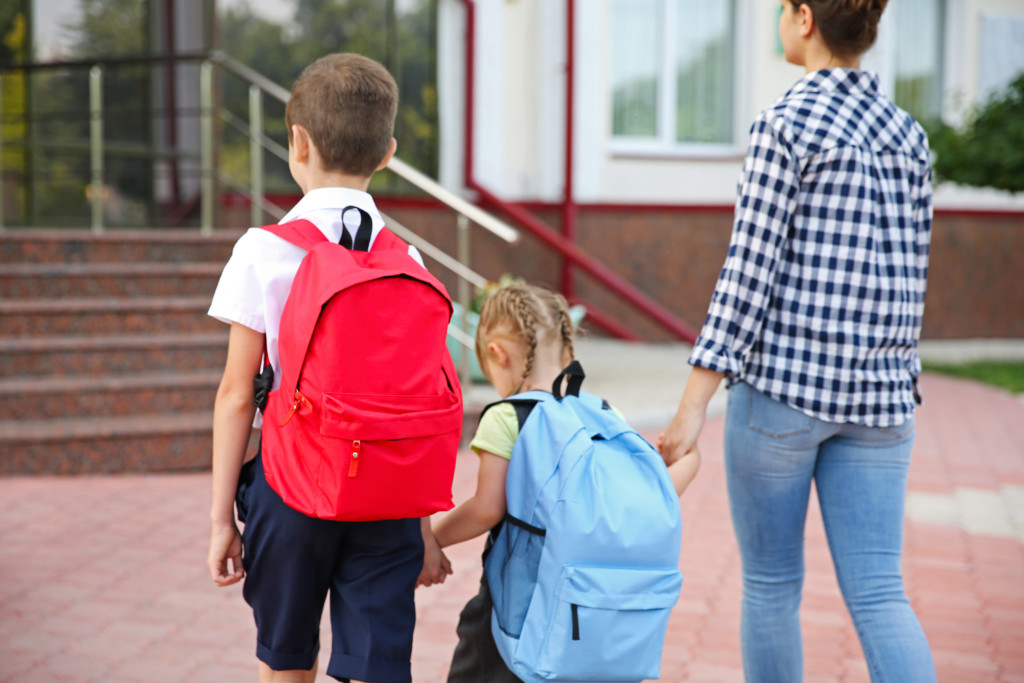
Support for school choice has increased since April 2020 by 8 percentage points, from 64% to 72%, according to a new poll from RealClear Opinion Research.
The largest increase in support for school choice came from Democrats (up 9 percentage points) followed by Republicans (7 percentage points) and registered Independents (7 percentage points). Overall Democratic support also was higher than registered Independents (68% compared to 67%) but lower than Republicans (82%).
Hispanic Americans were the most likely to support school choice (77%) compared to white Americans (72%) and Black Americans (70%). Asian Americans showed the least support (66%) and were more likely to oppose school choice (26%).
Tommy Schultz, CEO of the American Federation for Children, called the poll numbers “stunning.”
“The past two years have exposed to the world what many in the parental choice movement have known for decades: no single educational environment is right for every child,” Schultz said. “As the battle over educational freedom continues, party affiliation is secondary to ensuring all families are empowered to choose the best educational setting for their children.”
Schultz warned policymakers:
“As these poll numbers show, there will be consequences if you go against the staggering majority of parents who support this issue.”
RealClear Opinion Research polled more than 2,000 registered voters Feb. 5-9 for the survey.
Other demographic research shows that in Florida, 48% of K-12 students utilize some form of school choice, up 45% from the previous year.
Public options, such as charter schools and district open enrollment, are among the most popular choices, but private school scholarships have been among the fastest growing. This year, 188,774 students received scholarships from Step Up For Students.
The scholarship administration nonprofit, which hosts this blog, manages four scholarship programs that allow students to attend private schools, including the Florida Tax Credit Scholarship, the Family Empowerment Scholarship for Educational Opportunities, the Family Empowerment Scholarship for Students with Unique Abilities, and the Hope Scholarship for victims of bullying, harassment and sexual assault.
Step Up also administers transportation scholarships allowing students to attend other public schools, as well as a Reading Scholarship to help public school students who struggle with reading and reading comprehension.

The School of St. Mary in Lake Forest, Illinois, has been recognized for three years by the National Blue Ribbon Schools Program for overall academic excellence.
Editor’s note: This commentary from Mark Glennon, founder and executive editor of Wirepoints, an independent, nonprofit company delivering original research and commentary about Illinois’ economy and government, appeared Tuesday on the Wirepoints site.
Rarely is anything so popular yet so neglected by politicians as school choice for K-12 education.
The public has it right on what is a truly righteous cause. For society to honor its fundamental obligation to educate its youth, parents must be offered an alternative to catastrophically failing schools. Society’s future demands it. Simple justice demands it. The state as a place to raise a family demands it. And it is indeed what it has often been called – a civil rights issue.
Polls and surveys consistently show overwhelming support for school choice, which has now reached all-time highs. A RealClear Opinion Research survey this year showed support for choice at 74% vs. just 16% opposed and 10% are unsure.
Support crosses party lines, with 83% of Republicans, 69% of Independents, and 70% of Democrats saying they strongly or somewhat support school choice. African-Americans, too, who disproportionately are forced into abysmal government schools, consistently say they want choice.
In short, “Education now rivals the economy” as the top issue for voters, which even the Washington Post had to admit.
It’s no different in Illinois, which has only a tiny school choice program of sorts, a tax credit scholarship mechanism capped at just $75 million annually. Earlier this year, Gov. JB Pritzker proposed to reduce the amount of the credit. But polling showed that 61% of Illinois voters support the bipartisan program, a 7-point increase since October 2020, including 71% of Black voters, 81% of Latino voters and 67% of Democratic voters.
Pritzker lost. With significant opposition to the cuts from within his own Democratic Party, the program was maintained. It was the only time in memory that Illinois lawmakers stood up to the interest group opposed to school choice – teachers’ unions.
Teachers’ unions may be the obstacle to school choice, but it might be a mistake to confuse teachers with teachers’ unions. A recent report by the conservative Heritage Foundation, based on a national survey it commissioned, found that teachers don’t share all of the radical positions of their unions and concluded that reformers may find more allies than expected among rank-and-file teachers.
Multiple factors are contributing to demands for school choice. Enraged parents are fed up with political indoctrination and woke radicalism in the classroom. They saw teachers’ unions standing in the schoolhouse door to keep them closed during the pandemic, and many parents remain angry about over-the-top COVID measures. They have seen school choice already working in many parts of the country, with more and more coming.
But the primary driver of demands for school choice is the abysmal performance of many government schools, and that failure is becoming particularly obvious in Illinois, especially Chicago.
Only 26% of Chicago public school 11th-graders can read and do math at grade level, as we recently reported. The district responded by dumbing down its standards, proudly announcing that 84% of students graduated from CPS in 2021 – a new record high.
Chicago is not alone. Abject failure is now common in government schools across much of Illinois. The Illinois Constitution says, “The State shall provide for an efficient system of high quality public educational institutions and services,” but the state is simply not doing that.
Over the coming months we will be documenting that failure and addressing the details of how school choice can work. It is not a funding failure, as we have often shown. It is a failure that can only be corrected by providing direct funding to parents so they can choose the schools that work best for them. Former Chicago Public Schools CEO Paul Vallas explained it well when he joined Wirepoints’ The Dialogue podcast recently.
School choice should be a top issue in next year’s elections. Politicians will start listening if voters start demanding what they say they want.
 Results from a new poll from RealClear Opinion Research indicates that voters have a problem with lawmakers who oppose school choice for others but exercise it for their own children.
Results from a new poll from RealClear Opinion Research indicates that voters have a problem with lawmakers who oppose school choice for others but exercise it for their own children.
According to a survey conducted this month of more than 2,000 registered voters, 62% would be less likely to vote for a candidate who opposes education choice policies yet sends his or her own children to a private school. The sentiment was evenly shared by those who identified as Democrat, Republican and Independent.
Researchers asked the question: If an elected official or political candidate sends their own children to private school but opposes school choice for other families, would that make you more likely to vote for that candidate, less likely to vote for that candidate, or would it not make a difference?
Here is the breakdown among political affiliation:
Democrats were 56% less likely to vote for such a candidate; Republicans were 66% less likely; and Independents were 65% less likely.
American Federation for Children CEO Tommy Schultz said in response to the poll results that it’s unfortunate that politicians block expanded educational opportunities for others while exercising that freedom for their own children.
“From president of the United States governors to state lawmakers and school board members, many in such places of privilege disregard the needs of families who want nothing but the same opportunity to access an educational environment that meets their own children’s needs,” Schultz said.
 A survey of 2,020 registered voters conducted by RealClear Opinion Research indicates support for school choice is surging as families become increasingly frustrated with district schools’ response to the coronavirus pandemic.
A survey of 2,020 registered voters conducted by RealClear Opinion Research indicates support for school choice is surging as families become increasingly frustrated with district schools’ response to the coronavirus pandemic.
Since April, overall support for the concept of school choice among families with children in public schools has jumped 10 percentage points, from 67% to 77% according to poll results released today.
That support is relatively even across political lines, with 76% of Republicans, 73% of Independents and 72% of Democrats responding affirmatively that they would support giving parents a portion of the $15,424 per student the average American taxpayer spends on K-12 public education for home, virtual or private education if public schools do not reopen for in-person classes.
Additionally, 78% of public school parents and 79% of non-public school parents said they would support the governor of their state putting federal funding for the purchase of education technology and materials, private school tuition and home education directly in the hands of families and allowing them to choose how to use those funds to support their child’s education.
Support for this effort also was evenly distributed among party lines, with 68% of Republicans, 68% of Independents, and 66% of Democrats agreeing.
“The inflexibility of our K-12 system is on full display, leaving families to scramble as the special interests that have controlled our public education system for generations continue to oppose giving families and students greater educational choice,” said John Schilling, president of the American Federation for Children. “It could not be more clear that families are desperate for other options and will support governors and other policymakers as they pursue policies that let them control their child's education funding.”
The RealClear poll was conducted Aug. 19-21 and carries a margin of error of +/1 2.4%.
More school choice polling can be found here.

While the reasons for Democratic presidential candidate and leading anti-charter stalwart Elizabeth Warren’s nearly 13-point polling plummet are multifaceted, a recent public confrontation with school choice supporters and the revelation that she sent her son to a $17,000-a-year private school likely contributed to the decline.
Warren’s strong anti-school choice stance probably isn’t working in her favor if education choice polls are any indication. A RealClear Opinion Research survey conducted this fall reported that 68 percent of Americans now support the concept of school choice.
The poll, sponsored by the American Federation for Children, included 2,014 registered voters. Forty-two percent identified as Democratic, 31 percent as Republican, and 28 percent as Independent.
Fully 70 percent of respondents said they support a federal tax credit scholarship program similar to the Florida Tax Credit Scholarship administered by Step Up For Students (which hosts this blog) that serves more than 100,000 lower-income students.
According to the American Federation for Children, the strongest support for a tax credit scholarship – 74 percent – came from respondents 45 to 54 years old. Meanwhile, 71 percent of black voters, the highest level of any racial demographic, were supportive. Latino voters also showed strong support with 69 percent favoring school choice.
In terms of political party, about 76 percent of Republicans and 64 percent of Democrats supported school choice options overall.
While 53 percent of respondents said they currently send their children to district-run public schools, given a choice, 70 percent would choose another educational option; 39 percent specifically identified their first choice as a private school.
The National Education Association, the nation’s largest teacher union and most vocal opponent of school choice vouchers and charter schools, has yet to endorse a presidential candidate for 2020. Though the union is expected to contribute millions of dollars to the presidential campaign, it remains to be seen if its endorsed candidate will be able to maintain an anti-education choice stance given public sentiment in favor of it, compounded by the fact that several swing states including Arizona and Florida have large education choice populations.
Other swing states, such as Michigan and Pennsylvania, have large charter school populations, and Pennsylvania also offers tax credit scholarships to thousands of lower- and middle-income students.